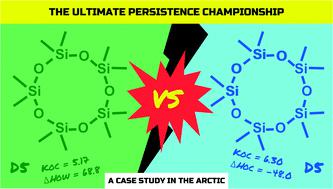当前位置:
X-MOL 学术
›
Environ. Sci.: Processes Impacts
›
论文详情
Our official English website, www.x-mol.net, welcomes your
feedback! (Note: you will need to create a separate account there.)
Investigating the presence and persistence of volatile methylsiloxanes in Arctic sediments.
Environmental Science: Processes & Impacts ( IF 4.3 ) Pub Date : 2020-04-29 , DOI: 10.1039/c9em00455f Dimitri Panagopoulos Abrahamsson 1 , Nicholas Alexander Warner , Liisa Jantunen , Annika Jahnke , Fiona Wong , Matthew MacLeod
Environmental Science: Processes & Impacts ( IF 4.3 ) Pub Date : 2020-04-29 , DOI: 10.1039/c9em00455f Dimitri Panagopoulos Abrahamsson 1 , Nicholas Alexander Warner , Liisa Jantunen , Annika Jahnke , Fiona Wong , Matthew MacLeod
Affiliation

|
Volatile methylsiloxanes (VMS) have been identified as contaminants of emerging concern in aquatic systems. Here, we report on the presence of VMS in sediment and wastewater from Arctic regions in 2014 to 2016 and model their persistence in Adventfjorden in Longyearbyen, Svalbard. Total concentrations of VMS in sediment were dominated by D4 and D5 and ranged from 0.0024 to 1.7 ng g-1 at Svalbard (Longyearbyen), from 4.0 to 43 ng g-1 in Greenland (Nuuk) and from 0.19 to 21 ng g-1 in the Canadian Archipelago. Concentrations in wastewater samples from Svalbard ranged from 12 to 156 ng L-1. Large variability in reported values of the partition ratio between organic carbon and water (KOC) and enthalpy of sorption (ΔHOC; often estimated from enthalpy of phase change between octanol and water, ΔHOW) of VMS has resulted in high uncertainty in evaluating persistence in aquatic systems. We evaluated previously reported KOC and ΔHOC values from the literature in predicting measured VMS concentrations in sediment and wastewater in scenarios using a fugacity-based multimedia model for VMS concentrations in Svalbard. We tested two different model scenarios: (1) KOC and ΔHOW measurements for three cyclic VMS previously reported by Kozerski et al. (Environ. Toxicol. Chem., 2014, 33, 1937-1945) and Xu and Kropscott (Environ. Chem., 2014, 33, 2702-2710) and (2) the KOC and ΔHOC measurements from Panagopoulos et al. (Environ. Sci. Technol., 2015, 49, 12161-12168 and Environ. Sci. Technol. Lett., 2017, 4(6), 240-245). Concentrations of VMS in sediment predicted from concentrations in wastewater in scenario 2 were in good agreement with measured concentrations, whereas in scenario 1, predicted concentrations were 2 to 4 orders of magnitude lower. Such large discrepancies indicate that the differences in the predicted concentrations are more likely to be attributed to KOC and ΔHOC than to uncertainty in environmental parameters or emission rates.
中文翻译:

调查北极沉积物中挥发性甲基硅氧烷的存在和持久性。
挥发性甲基硅氧烷(VMS)已被确定为水生系统中令人关注的污染物。在这里,我们报告了2014年至2016年北极地区沉积物和废水中存在VMS的情况,并模拟了它们在斯瓦尔巴特群岛朗伊尔城Adventfjorden的持久性。沉积物中VMS的总浓度以D4和D5为主,斯瓦尔巴特群岛(Longyearbyen)的浓度范围为0.0024至1.7 ng g-1,格陵兰(Nuuk)的浓度范围为4.0至43 ng g-1,0.19至21 ng g-1在加拿大群岛。斯瓦尔巴特群岛废水样本中的浓度范围为12至156 ng L-1。报告的有机碳与水之间的分配比(KOC)和吸附焓(ΔHOC)的差异很大,通常根据辛醇和水之间的相变焓进行估算,VMS的ΔHOW)在评估水生系统中的持久性方面存在很高的不确定性。我们使用基于散度的斯瓦尔巴特群岛VMS浓度多媒体模型预测了情景中沉积物和废水中的VMS浓度,从而评估了文献中先前报告的KOC和ΔHOC值。我们测试了两种不同的模型场景:(1)先前由Kozerski等人报告的三个循环VMS的KOC和ΔHOW测量。(Environ。Toxicol。Chem。,2014,33,1937-1945)和Xu and Kropscott(Environ。Chem。,2014,33,2702-2710)和(2)Panagopoulos等人的KOC和ΔHOC测量值。(Environ.Sci.Technol。,2015,49,12161-12168和Environ.Sci.Technol.Lett。,2017,4(6),240-245)。根据方案2中废水的浓度预测的沉积物中VMS的浓度与实测浓度高度吻合,而在方案1中,预测浓度要低2-4个数量级。如此大的差异表明,与环境参数或排放速率的不确定性相比,预测浓度的差异更可能归因于KOC和ΔHOC。
更新日期:2020-01-27
中文翻译:

调查北极沉积物中挥发性甲基硅氧烷的存在和持久性。
挥发性甲基硅氧烷(VMS)已被确定为水生系统中令人关注的污染物。在这里,我们报告了2014年至2016年北极地区沉积物和废水中存在VMS的情况,并模拟了它们在斯瓦尔巴特群岛朗伊尔城Adventfjorden的持久性。沉积物中VMS的总浓度以D4和D5为主,斯瓦尔巴特群岛(Longyearbyen)的浓度范围为0.0024至1.7 ng g-1,格陵兰(Nuuk)的浓度范围为4.0至43 ng g-1,0.19至21 ng g-1在加拿大群岛。斯瓦尔巴特群岛废水样本中的浓度范围为12至156 ng L-1。报告的有机碳与水之间的分配比(KOC)和吸附焓(ΔHOC)的差异很大,通常根据辛醇和水之间的相变焓进行估算,VMS的ΔHOW)在评估水生系统中的持久性方面存在很高的不确定性。我们使用基于散度的斯瓦尔巴特群岛VMS浓度多媒体模型预测了情景中沉积物和废水中的VMS浓度,从而评估了文献中先前报告的KOC和ΔHOC值。我们测试了两种不同的模型场景:(1)先前由Kozerski等人报告的三个循环VMS的KOC和ΔHOW测量。(Environ。Toxicol。Chem。,2014,33,1937-1945)和Xu and Kropscott(Environ。Chem。,2014,33,2702-2710)和(2)Panagopoulos等人的KOC和ΔHOC测量值。(Environ.Sci.Technol。,2015,49,12161-12168和Environ.Sci.Technol.Lett。,2017,4(6),240-245)。根据方案2中废水的浓度预测的沉积物中VMS的浓度与实测浓度高度吻合,而在方案1中,预测浓度要低2-4个数量级。如此大的差异表明,与环境参数或排放速率的不确定性相比,预测浓度的差异更可能归因于KOC和ΔHOC。











































 京公网安备 11010802027423号
京公网安备 11010802027423号